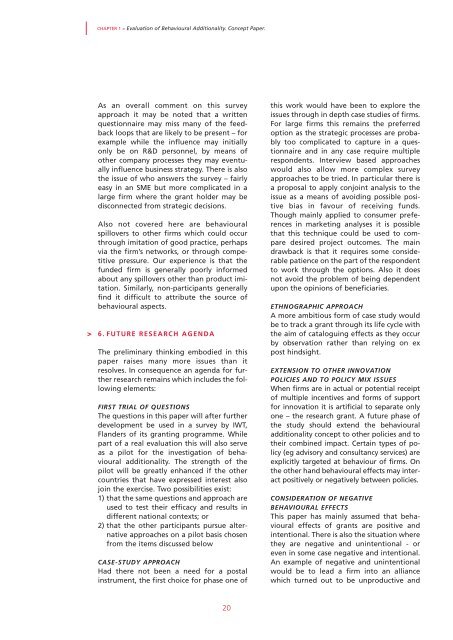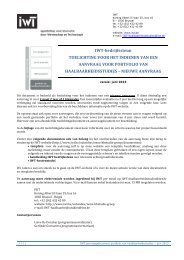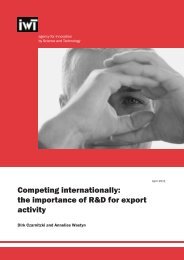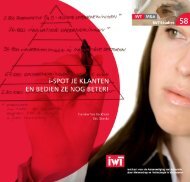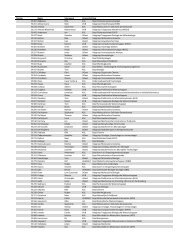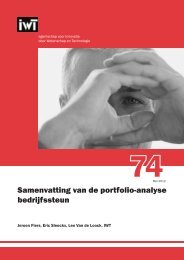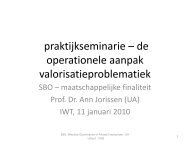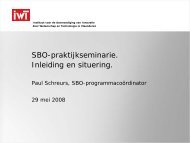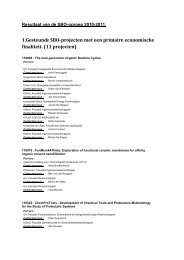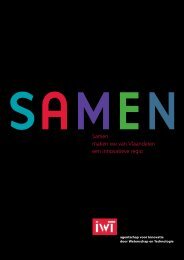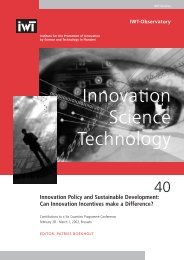The Evaluation of 'Behavioural Additionality' - IWT
The Evaluation of 'Behavioural Additionality' - IWT
The Evaluation of 'Behavioural Additionality' - IWT
Create successful ePaper yourself
Turn your PDF publications into a flip-book with our unique Google optimized e-Paper software.
CHAPTER 1 > <strong>Evaluation</strong> <strong>of</strong> Behavioural Additionality. Concept Paper.<br />
><br />
As an overall comment on this survey<br />
approach it may be noted that a written<br />
questionnaire may miss many <strong>of</strong> the feedback<br />
loops that are likely to be present – for<br />
example while the influence may initially<br />
only be on R&D personnel, by means <strong>of</strong><br />
other company processes they may eventually<br />
influence business strategy. <strong>The</strong>re is also<br />
the issue <strong>of</strong> who answers the survey – fairly<br />
easy in an SME but more complicated in a<br />
large firm where the grant holder may be<br />
disconnected from strategic decisions.<br />
Also not covered here are behavioural<br />
spillovers to other firms which could occur<br />
through imitation <strong>of</strong> good practice, perhaps<br />
via the firm’s networks, or through competitive<br />
pressure. Our experience is that the<br />
funded firm is generally poorly informed<br />
about any spillovers other than product imitation.<br />
Similarly, non-participants generally<br />
find it difficult to attribute the source <strong>of</strong><br />
behavioural aspects.<br />
6. FUTURE RESEARCH AGENDA<br />
<strong>The</strong> preliminary thinking embodied in this<br />
paper raises many more issues than it<br />
resolves. In consequence an agenda for further<br />
research remains which includes the following<br />
elements:<br />
FIRST TRIAL OF QUESTIONS<br />
<strong>The</strong> questions in this paper will after further<br />
development be used in a survey by <strong>IWT</strong>,<br />
Flanders <strong>of</strong> its granting programme. While<br />
part <strong>of</strong> a real evaluation this will also serve<br />
as a pilot for the investigation <strong>of</strong> behavioural<br />
additionality. <strong>The</strong> strength <strong>of</strong> the<br />
pilot will be greatly enhanced if the other<br />
countries that have expressed interest also<br />
join the exercise. Two possibilities exist:<br />
1) that the same questions and approach are<br />
used to test their efficacy and results in<br />
different national contexts; or<br />
2) that the other participants pursue alternative<br />
approaches on a pilot basis chosen<br />
from the items discussed below<br />
CASE-STUDY APPROACH<br />
Had there not been a need for a postal<br />
instrument, the first choice for phase one <strong>of</strong><br />
this work would have been to explore the<br />
issues through in depth case studies <strong>of</strong> firms.<br />
For large firms this remains the preferred<br />
option as the strategic processes are probably<br />
too complicated to capture in a questionnaire<br />
and in any case require multiple<br />
respondents. Interview based approaches<br />
would also allow more complex survey<br />
approaches to be tried. In particular there is<br />
a proposal to apply conjoint analysis to the<br />
issue as a means <strong>of</strong> avoiding possible positive<br />
bias in favour <strong>of</strong> receiving funds.<br />
Though mainly applied to consumer preferences<br />
in marketing analyses it is possible<br />
that this technique could be used to compare<br />
desired project outcomes. <strong>The</strong> main<br />
drawback is that it requires some considerable<br />
patience on the part <strong>of</strong> the respondent<br />
to work through the options. Also it does<br />
not avoid the problem <strong>of</strong> being dependent<br />
upon the opinions <strong>of</strong> beneficiaries.<br />
ETHNOGRAPHIC APPROACH<br />
A more ambitious form <strong>of</strong> case study would<br />
be to track a grant through its life cycle with<br />
the aim <strong>of</strong> cataloguing effects as they occur<br />
by observation rather than relying on ex<br />
post hindsight.<br />
EXTENSION TO OTHER INNOVATION<br />
POLICIES AND TO POLICY MIX ISSUES<br />
When firms are in actual or potential receipt<br />
<strong>of</strong> multiple incentives and forms <strong>of</strong> support<br />
for innovation it is artificial to separate only<br />
one – the research grant. A future phase <strong>of</strong><br />
the study should extend the behavioural<br />
additionality concept to other policies and to<br />
their combined impact. Certain types <strong>of</strong> policy<br />
(eg advisory and consultancy services) are<br />
explicitly targeted at behaviour <strong>of</strong> firms. On<br />
the other hand behavioural effects may interact<br />
positively or negatively between policies.<br />
CONSIDERATION OF NEGATIVE<br />
BEHAVIOURAL EFFECTS<br />
This paper has mainly assumed that behavioural<br />
effects <strong>of</strong> grants are positive and<br />
intentional. <strong>The</strong>re is also the situation where<br />
they are negative and unintentional - or<br />
even in some case negative and intentional.<br />
An example <strong>of</strong> negative and unintentional<br />
would be to lead a firm into an alliance<br />
which turned out to be unproductive and<br />
20


